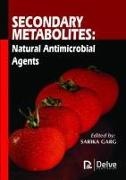Condividi
Fr. 232.80
Sarika Garg
Secondary Metabolites: Natural Antimicrobial Agents
Inglese · Copertina rigida
Spedizione di solito min. 4 settimane (il titolo viene procurato in modo speciale)
Descrizione
Metabolites are the molecules produced by plants. They have various functions and are categorized into primary metabolites and secondary metabolites. Primary metabolites, often referred to as central metabolites, are the key components involved in growth, development and reproduction of the organism. On the other hand, secondary metabolites are the organic compounds that are commonly generated through the modification of primary metabolite involving number of biochemical reactions. The research studies on secondary metabolites have increased over the years. These metabolites play a significant role in the adaptation of plants to their environment and are also considered as vital source of active pharmaceuticals. Secondary metabolites are not directly involved in primary functions viz. growth, development and reproduction. These secondary metabolites are a diverse group, many of which are significant in industrial microbiology. These compounds exhibit several biological activities including antimicrobial, antifungal, anticancer and anti-inflammatory activities. They have a role as antioxidants, antibiotics, flavorings, metal transporting agents, differentiation effectors, etc. They are also involved in ecology and plant defense mechanism. Their protective value is exhibited by their negative impacts on organisms such as herbivores and pathogens. However, some secondary metabolites can also have severe consequences.Various secondary metabolites are produced by plant cells for defense mechanisms against bacteria. The substances viz. alkaloids, flavonoids, tannins, terpenes, quinones and certain resins are categorized as secondary metabolites. This book mainly discusses the antimicrobial property of different secondary metabolites and is a collection of few recent research studies on secondary metabolites by various scientists. The first chapter is the introduction chapter discussing various secondary metabolites and their functions. Chapter 2 highlights the antibacterial properties of alkaloid extracts from Callistemon citrinus and Vernonia adoensis against Staphylococcus aureus and Pseudomonas aeruginosa. In chapter 3, the antibacterial activity of the alkaloid extract from the leaves of Croton bonplandianum Baill. against Staphylococcus aureus, Escherichia coli, Klebsiella pneumoniae and Pseudomonas aeruginosa is described. The antimicrobial activity of the pure alkaloids of Z. rhoifolium and of the marine alkaloids is evaluated in the following two chapters, respectively. The antimicrobial activity of the quinoline derivatives is discussed in chapter 6. Chapter 7 comprises of the evaluation of the antimicrobial and other properties of the novel quinine isolated from Aegle marmelos (Linn.) Correa. The antimicrobial effects of the catechins found in green tea have been discussed in chapter 8. Next chapter is on the investigation of the antibacterial properties of quercetin against amoxicillin-resistant Staphylococcus epidermidis (ARSE). Anti-biofilm properties of the cranberry proanthocyanidins against Pseudomonas aeruginosa, antimicrobial property of two biflavonoids and a flavone isolated from Podocarpus henkelii (Podocarpaceae) leaves, and the antibacterial activity of black tea and its theaflavin derivatives are described in the following three chapters, respectively. In chapters 13-15, essential oil, limonene and α-terpineol and their properties have been discussed, respectively. Antimicrobial activity of tannins in Stryphnodendron adstringens and the antibacterial activity of the tannins extracted from astringent persimmon against polymicrobial (PM) biofilms are presented in chapters 16 and 17, respectively. Antibacterial activities of saponin fractions of Erythropheleum suaveolens are indicated in chapter 18. The last three chapters of the book discuss the antimicrobial activities of Calpurnia aurea, Vernonia polyanthes and Cleome spinosa Jaqc., respectively.
Info autore
Sarika Garg procured her doctoral degree at the Max Planck Unit For Structural Molecular Biology, University of Hamburg, Germany in 2011. This was followed by Postdoctoral Scientist position at University of Saskatchewan, Canada. Later, she moved to CRCHUM, University of Montreal for her second Postdoc. She has diverse research interests and has contributed immensely in many research fields viz. Enzyme Technology, Environmental Science, and Neuroscience. She has numerous research papers and review articles to her credit. She has coauthored two books Enzymes & Enzyme Technology; and Biochemical Tests: Principles and Protocols. She has also contributed several chapters in various books including a chapter on Regulation of Gene Expression in Encyclopedia of Molecular Cell Biology and Molecular Medicine. She is a recipient of 2012 SHRF Postdoctoral Fellowship Award and 2012 Laura E. Chapman Research Award. She is currently working as a Career Counselor in her very own venture ‘higherstudiescounseling.com’, Montreal, Canada and as a freelancer science writer.
Riassunto
Metabolites are produced by plant cells as a defense mechanism against bacteria. This book discusses the antimicrobial property of different secondary metabolites, presenting a collection of recent research studies by scientists.
Dettagli sul prodotto
| Con la collaborazione di | Sarika Garg (Editore) |
| Editore | Delve Publishing |
| Lingue | Inglese |
| Formato | Copertina rigida |
| Pubblicazione | 28.02.2018 |
| EAN | 9781773611204 |
| ISBN | 978-1-77361-120-4 |
| Pagine | 370 |
| Categoria |
Scienze naturali, medicina, informatica, tecnica
> Scienze naturali, tematiche generali
|
Recensioni dei clienti
Per questo articolo non c'è ancora nessuna recensione. Scrivi la prima recensione e aiuta gli altri utenti a scegliere.
Scrivi una recensione
Top o flop? Scrivi la tua recensione.

